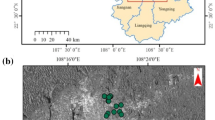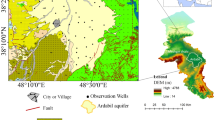Abstract
The City of Xian, China, has been experiencing significant land subsidence and ground fissure activities since 1960s, which have brought various severe geohazards including damages to buildings, bridges and other facilities. Monitoring of land subsidence and ground fissure activities can provide useful information for assessing the extent of, and mitigating such geohazards. In order to achieve robust Synthetic Aperture Radar Interferometry (InSAR) results, six interferometric pairs of Envisat ASAR data covering 2005–2006 are collected to analyze the InSAR processing errors firstly, such as temporal and spatial decorrelation error, external DEM error, atmospheric error and unwrapping error. Then the annual subsidence rate during 2005–2006 is calculated by weighted averaging two pairs of D-InSAR results with similar time spanning. Lastly, GPS measurements are applied to calibrate the InSAR results and centimeter precision is achieved. As for the ground fissure monitoring, five InSAR cross-sections are designed to demonstrate the relative subsidence difference across ground fissures. In conclusion, the final InSAR subsidence map during 2005–2006 shows four large subsidence zones in Xian hi-tech zones in western, eastern and southern suburbs of Xian City, among which two subsidence cones are newly detected and two ground fissures are deduced to be extended westward in Yuhuazhai subsidence cone. This study shows that the land subsidence and ground fissures are highly correlated spatially and temporally and both are correlated with hi-tech zone construction in Xian during the year of 2005–2006.








Similar content being viewed by others
References
Amelung F, Galloway DL, Bell JW, Zebker HA, Laczniak RJ (1999) Sensing the ups and downs of Las Vegas: InSAR reveals structural control of land subsidence and aquifer-system deformation. Geology 27(6):483–486
Baran I, Stewart M, Kampes B, Perski Z, Lilly P (2003) A modification to the Goldstein radar interferogram filter. IEEE Trans Geosci Remote Sens 41(9):2114–2118
Gabriel AK, Goldstein RM, Zebker HA (1989) Mapping small elevation changes over large areas: differential radar interferometry. J Geophys Res 94:9183–9191
Liu GX, Ding XL, Chen YQ, Li ZL, Li ZW (2001) Settlement field of Chek Lap Kok airport, HongKong, detected by satellite synthetic aperture radar interferometry. Chin Sci Bull 46:1778–1782
Lu Z, Patrick M, Fielding EJ, Trautwein C (2003) Lava volume from the 1997 eruption of Okmok volcano, Alaska, estimated from spaceborne and airborne interferometric synthetic aperture radar. IEEE Trans Geosci Remote Sens 41:1428–1436
Massonnet D, Feigl KL (1998) Radar interferometry and its application to changes in the Earth’s surface. Rev Geophys 36:441–500
Massonnet D, Rossi M, Carmona C, Adragna F, Peltzer G, Feigl K, Rabaute T (1993) The displacement field of the Landers earthquake mapped by radar interferometry. Nature 364(6433):138–142
Mi FS, Zhang ZX (2001) Disasters of Xian ground fissures and controlling measures. Res Soil Water Conserv 18(1):155–159
Peng JB, Su SR, Zhang J (1992) The active faults and geohazards in Weihe basin. Northwest university Press, Xian
Rogers AEE, Ingalls RP (1969) Venus: mapping the surface reflectivity by radar interferometry. Science 165(3895):797–799
Rosen P, Hensley SH, Zebker H, Webb FH, Fielding EJ (1996) Surface deformation and coherence measurements of Kilauea volcano, Hawaii, from SIR-C radar interferometry. J Geophys Res 101:23109–23125
Suo CM, Wang DQ, Liu ZZ (2005) Land fracture and subsidence prevention in Xian. Quat Res 25(1):23–28
Tao H (1999) The land subsidence map in Xian city, in Shaanxi Geology and minerals resources bureau, Shaanxi proposal committee. Xian environmental geological Atlas. Xian Mapping Press, Xian
Wang DQ, Suo CM, Jia SJ (1996) A quantitative analysis of recently extraordinary movement factors of geofractures in Xian. Geol Shaanxi 14(1):49–58
Wang JM (2000) Theory of ground fissures hazards and its application. Shaanxi Science and Technology Press, Xian
Xian city planning bureau, Institute of geotechnical investigation and design MMI and China Northwest Building Design Research Institute (2006) Regulations of field reconnaissance and engineering design on Xian ground fissures, No. DBJ61-6-2006
Yan WZ (1998) Analysis on the origin of land subsidence and its countermeasures of control in Xian. Chin J Geol Hazard Control 119:27–32
Yan WZ (1999) Xian ground fissures map, in Shaanxi Geology and minerals resources bureau, Shaanxi proposal committee, Xian Environmental geological Atlas. Xian Mapping press, Xian
Zebker HA, Goldstein RM (1986) Topographic mapping from interferometric synthetic aperture radar observations. J Geophys Res 91(B5):4993–4999
Zebker HA, Rosen PA, Goldstein RM, Gabriel A, Werner CL (1994) On the derivation of coseismic displacement fields using differential radar interferometry: the Landers earthquake. J Geogr Res 99:19617–19634
Zhang JM (1990) Research on ground fracture in the region of Xian. Northwest University Press, Xian
Zhang Q, Huang GW, Wang L, Wu XZ, Ding XG (2007) Applied research of monitoring the Xian land subsidence and land fissure using GPS surveying (in Chinese). J Eng Geol 6(15):P828–P833
Zhao CY, Ding XL, Zhang Q, Lu Z, Li ZW (2008) Monitoring of recent land subsidence and ground fissures in Xi’an With SAR interferometry, ISPRS proceedings 2008 Beijing, B1, TCI,pp 147–150
Zisk SH (1972) A new Earth-based radar technique for the measurement of lunar topography. Moon 4:296–300
Acknowledgments
Envisat ASAR data are provided by ESA Category 1 and this research is funded by two general projects of the Natural Science Foundation of China (NSFC) (project No: 40672173 and 40802075) and one key project of the Ministry of Land & Resources, China (project No: 1212010440410), and above all special thanks to the reviewer of this paper for his helpful comments.
Author information
Authors and Affiliations
Corresponding author
Rights and permissions
About this article
Cite this article
Zhao, C.Y., Zhang, Q., Ding, X.L. et al. Monitoring of land subsidence and ground fissures in Xian, China 2005–2006: mapped by SAR interferometry. Environ Geol 58, 1533–1540 (2009). https://doi.org/10.1007/s00254-008-1654-9
Received:
Accepted:
Published:
Issue Date:
DOI: https://doi.org/10.1007/s00254-008-1654-9




